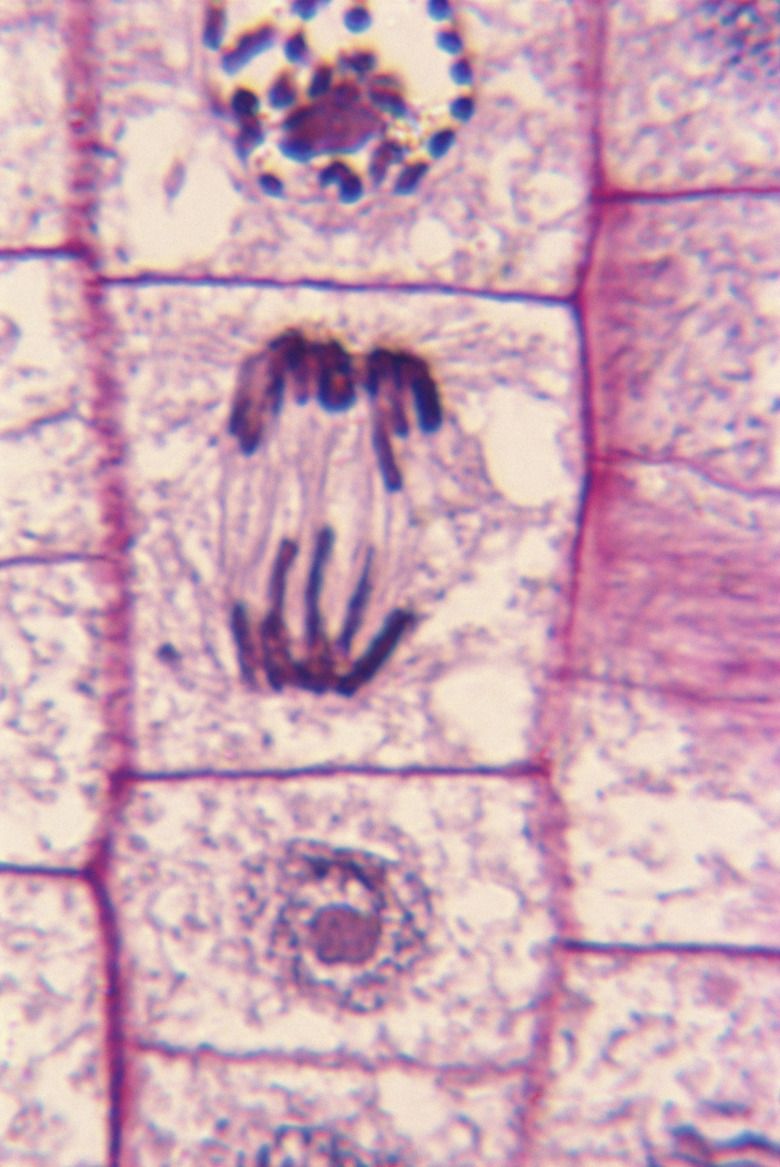Why Is Mitosis A Form Of Asexual Reproduction?
If you have ever observed a drop of pond water under a microscope, you may have seen a menagerie of squiggly single-celled plants and animals. Eukaryotic micro-organisms typically reproduce asexually, meaning single cells duplicate their own chromosomal DNA and then divide into two identical cells to maintain the population. Mitosis enables primary food chain producers like diatoms to multiply quickly and abundantly. Complex multicellular organisms with specialized sex cells reproduce sexually, which involves gamete formation and recombining genes through meiosis to achieve biodiversity within the species.
Mitosis Definition
Mitosis Definition
"Mitosis is a cell-cycle stage during which condensed chromosomes migrate to the middle of the cell and segregate into two daughter nuclei before cytokinesis (cell division) with the aid of a dynamic mitotic spindle," as defined by a 2014 article in Cold Springs Harbor Perspectives in Biology. After mitosis, the parent cell ends up being one of two identical daughter cells. Next, the two daughter cells continue to grow and replicate their innards, in preparation for another cell cycle.
The Process of Mitosis
The Process of Mitosis
Interphase is the stage in the cell cycle that precedes the mitotic phases. The nucleus, nucleoli and nuclear membrane remain intact. Organelles make energy for cell growth, and genetic material is duplicated producing homologous (identical) chromatid pairs connected by a centromere in the middle. No division is occurring.
In prophase, the identical sister chromatids – made of DNA and protein – become visible in the nucleus and look like an X under a microscope. Protein strands called microtubules start forming; they'll soon capture the chromatids and pull them apart. The nuclear envelope dissolves and releases the chromosome pairs into the cytoplasm, still attached to a centromere.
Metaphase is an easy stage to identify because the spindle fibers grip the centromeres and neatly align the sister chromatids along the cell's equator (middle), which is also called the metaphase plate. Division will not proceed until all the chromatids are lined up and securely attached to the spindle apparatus. Many sources place an intermediate stage between prophase and metaphase, called prometaphase.
Anaphase occurs when chromosomes are pulled apart. Motor proteins assist in getting the separated chromatid pairs to opposite poles. Spindle fibers cause the cell to elongate.
In telophase a nuclear envelope forms around the chromosomes at each pole, and the tightly wound chromosomes start to unravel. The mitotic spindle starts to dissolve. Cytoplasm and organelles are divvied up and a cleavage furrow (or cell plate in plants) splits the two cells during cytokinesis**.**
Mitosis: Sexual or Asexual?
Mitosis: Sexual or Asexual?
Mitosis is a form of asexual reproduction in simple living organisms. The outcome of each cell cycle is two identical cells. Mitotic checkpoints happen at certain stages of mitosis to ensure that each cell receives the same amount of DNA. Errors must be corrected or division halted because too many or too few chromosomes can harm the new cells.
Sexual reproduction happens through meiosis. In the first phase of meiosis, matching chromosomes pair up and swap gene snippets. That's why children with the same parents may or may not look alike. Errors in meiosis can result in chromosomal abnormalities and disease when gene functioning is impaired.
Why Mitosis Matters for Survival
Why Mitosis Matters for Survival
Many small organisms rely predominately on mitosis or a similar process like budding to stay alive and self-perpetuate. In larger organisms, mitosis plays a different kind of role in survival. All of the body's non-reproductive cells divide by mitosis, such as skin cells, muscle cells and blood cells. Mitosis helps organisms grow, heal wounds and replace countless cells that are shed every minute.
Some organisms can produce asexually or sexually depending on circumstances. For instance, diatoms predominately reproduce asexually, but they also divide through a type of meiosis. According to a 2015 article in BioMed Central Genomics, "Besides the fundamental goal of sexual reproduction to generate genetic diversity within a population, in diatoms, the sexual phase also plays a key role in cell size restitution." In other words, some organisms that normally divide asexually may switch to sexual reproduction when one organism becomes too small to divide into two organisms.
Cite This Article
MLA
Dowd, Mary. "Why Is Mitosis A Form Of Asexual Reproduction?" sciencing.com, https://www.sciencing.com/mitosis-form-asexual-reproduction-19408/. 5 April 2019.
APA
Dowd, Mary. (2019, April 5). Why Is Mitosis A Form Of Asexual Reproduction?. sciencing.com. Retrieved from https://www.sciencing.com/mitosis-form-asexual-reproduction-19408/
Chicago
Dowd, Mary. Why Is Mitosis A Form Of Asexual Reproduction? last modified March 24, 2022. https://www.sciencing.com/mitosis-form-asexual-reproduction-19408/
